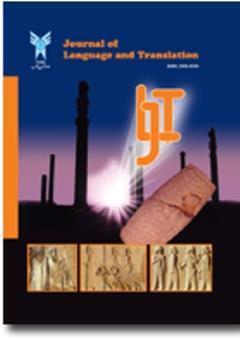Discourse Analysis Approach to Euphemism at Word and Sentence Level: A Case of Political Speech
Subject Areas :Esmaeil Azizi 1 , Abdolhossein Ahmadi 2 * , Mohammad Bavali 3
1 - Department of English, Shiraz Branch, Islamic Azad University, Shiraz, Iran
2 - Department of English, Larestan Branch, Islamic Azad University, Lar, Iran
3 - Department of English, Shiraz Branch, Islamic Azad University, Shiraz, Iran
Keywords: Euphemism, Political discourse, Iranian politicians, American politicians,
Abstract :
This study was a critical discourse analysis of the US and Iran’s politician speeches from 2013 to 2015 on the issue of nuclear negotiations in order to show how a single reality like nuclear agreement was presented and viewed by the politicians of the United States and Iran. Using Van Dijk’s (2004) framework, this study investigated how the politicians of each country try to justi-fy their ideas and persuade their audience by utilizing subtle ideological discourse structures in their speech. In doing so, the present study tried to identify the similarities and differences be-tween English and Persian political discourse regarding euphemism on the basis of the frequen-cy of each category. Having analyze data via descriptive statistics and chi-square methods, the results of the speeches indicated that politicians employ euphemistic strategies related to au-thority and evidentiality to establish a framework for burden or topos, which facilitates robust arguments against specific topics. In essence, they present substantial evidence or validation through references to authoritative figures, including esteemed experts, moral leaders, and repu-table international organizations. By citing trustworthy individuals, scholarly articles, and rele-vant scenarios, they aim to project objectivity, reliability, and credibility. This approach serves to bolster their claims and perspectives within an argument, rendering their assertions self-evident, adequate, rational, and plausible.
Allan, K. & Burridge, K. (1991). Euphe-mism and Dysphemism. Language Used as Shield and Weapon. Oxford and New York: Oxford University Press.
Austin, J. L. (1962). How to do things with words. Harvard University Press.
Badakhshan, E. & Mousavi, S. (2013). A Linguistic Analysis of Euphemism in Persian. Language Related Research, 5(1), 1-27.
Bull, P., & Fetzer, A. (2006). "Who are we and who are you? The strategic use of forms of address in political inter-views" Text & Talk, 26(1), 3-37. https://doi.org/10.1515/TEXT.2006.002
Burridge, K. (2012). Euphemism and lan-guage change. The sixth and seventh ages. Lexis. E-Journal in English Lex-icology, 7, 65–92.
Chilton, P. (2004). Analysing political dis-course: Theory and practice. Routledge.
Chilton, P., A. & Schäffner, C., (1997). Discourse and politics. In Van Dijk, Teun A. (Eds.) Discourse in social in-teraction (pp. 206- 230). London: SAGE.
Crespo-Fernández, E. (2014). Euphemism and political discourse in the British regional press. Brno Studies in Eng-lish, 40 (1), 5-26.
Fairclough, N. (1992). Discourse and social change. Oxford: Blackwell.
Fairclough, N. (1995). Critical discourse analysis: The critical study of lan-guage. London: Longman.
Fairclough, N. (2005). Critical Discourse Analysis in transdisciplinary research. In R. Wodak, & P. Chilton (Eds.), A new agenda in (Critical) Discourse Analysis: Theory, methodology and interdisciplinarity (pp. 53–70). Am-sterdam/Philadelphia: John Benja-mins.
Håkansson, J. (2012). The Use of Personal Pronouns in Political Speeches: A comparative study of the pronominal choices of two American presidents.
Jaganegara, H., & Wijana, I. D. P. (2023). Euphemism roles as a disguise tool in political texts: A case study of Tempo online political articles. SULUK: Jurnal Bahasa, Sastra, Dan Budaya, 5(1), 1–19. https://doi.org/10.15642/suluk.2023.5.1.1-19
Ilić, M. B. & Radulović., M. (2014). Mar-ginalizing commitment: syntactic eu-phemisms in political speeches. Lin-guistics and Literature, 12(1), 25 – 41.
Kameneva, V. A., & Rabkina, N. V. (2020). Euphemization of political discourse with elected and derived political power. The European Proceedings of Social and Behavioural Sciences. https://doi.org/10.15405/epsbs.2020.10.05.257
Lutz, W. (1990). The world of doublespeak. USA Today, 119 (2544), 34-36.
Ross, A. S., & Rivers, D. (2018). The socio-linguistics of hip-hop as critical con-science: Dissatisfaction and dis-sent. Palgrave MacMillan.
Van Dijk, T. A. (1993). Principles of critical discourse analysis. Discourse & soci-ety, 4 (2), 249–283.
Van Dijk, T. A. (1997). What is polit-ical discourse analysis? In Blom-maert, Jan and Chris Bulcaen (Eds.), Political Linguistics (pp. 11- 52). Am-sterdam and Philadelphia: John Ben-jamins.
Van Dijk, T.A. (2004). Politics, ideology and discourse. Retrieved Febuary 20, 2008 from http://www.discourse-in-society.org/teun.html.
Van Dijk, T. A. (2006). Discourse and ma-nipulation. Discourse & Society, 17(3), 359-383. https://doi.org/10.1177/0957926506060250
Van Dijk TA. (2008). Discourse and con-text: A sociocognitive approach. Cambridge: Cambridge University Press.
Wodak, R., & Meyer, M. (2015). Critical discourse studies: History, agenda, theory and methodology. In R. Wodak & M. Meyer (Eds.), Methods of critical discourse studies (pp. 1–22). London: Sage.
Yafarova, G. H. (2015). Euphemisms as semantic shifts in the political dis-course of German. Philological sci-ences. Quest of theory and practice., 10-1(52), 214–217.
Zhao, X. (2010). Study on the features of English political euphemism and its social functions. English Language Teaching, 3(1), 118 – 121.

